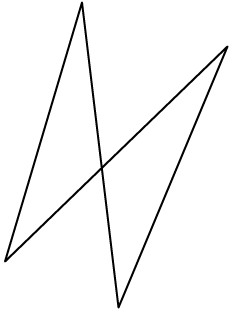Lesson 10
1. Lesson 10
1.9. Explore 5
Module 2: Logic and Geometry
Did You Know?
The National Gallery of Canada website has a virtual exhibition that contains some of the work of artist
M. C. Escher. The exhibit M.C. Escher Mindscapes contains examples of Escher’s work including his tessellations. M. C. Escher used the laws of geometry to create tessellations that fill entire sheets with recognizable and identical forms. Type the keyword “tessellation” or “M.C. Escher” into your favourite Internet search engine to see more examples of tessellations.
The National Gallery of Canada and the pyramid at the entrance to the Louvre Museum in France both contain tessellations in their building designs. Tessellations are arrangements of figures on a plane that completely cover a surface without gaps or overlaps. They are repeating patterns created by a series of translations, reflections, or rotations of polygons. Only polygons whose interior angles add up to 360° or a multiple of 360° will tessellate.

Hemera/Thinkstock
Read “Example 4: Reasoning about congruency to prove an angle relationship” on pages 110 and 111 of your textbook. Two strategies for proving that the base angles on each face of the Louvre pyramid are equal are provided. After you have worked through each student’s solution shown in your textbook, think about which strategy you prefer and why you prefer that strategy. Remember that both strategies give the same answer, so one is not more correct than the other. You must decide which strategy works for you in each question. Be sure to check your work to ensure you have correctly applied the angle properties and used correct reasoning.
Depending on the information given, there may be a number of approaches that can be used to complete a proof. For instance, properties relating to angles and parallel lines, triangles, and circles may be used to develop a proof. Remember back to your Mathematics 9 course. You studied angles relating to circles. You can also use these angle properties in developing your proofs.
Consider the following.

Marie-Josie is a stained glass artist. A client has asked her to create a stained glass window based on the following design. One of the client’s requirements is that the two triangles used in the design are the same.
Before Marie-Josie begins construction of the stained glass window, she needs to verify that the two triangles provided by her client are in fact congruent. Use the applet Stained Glass Proof to view and then analyze Marie-Josie’s proof.
As you have seen throughout this module, errors in reasoning result in invalid proofs. If the errors are not fixable, then the proof is not valid. If the errors can be corrected, a valid proof can be produced.
The two triangles in Marie-Josie client’s stained glass design were not congruent. In this case, the error in reasoning could not be fixed to prove that the triangles were the same because the triangles were not congruent. Additional information about the side lengths of the triangle would have shown that the triangles were not congruent. Marie-Josie needs to go back to her client with a design that she can prove contains congruent triangles.
